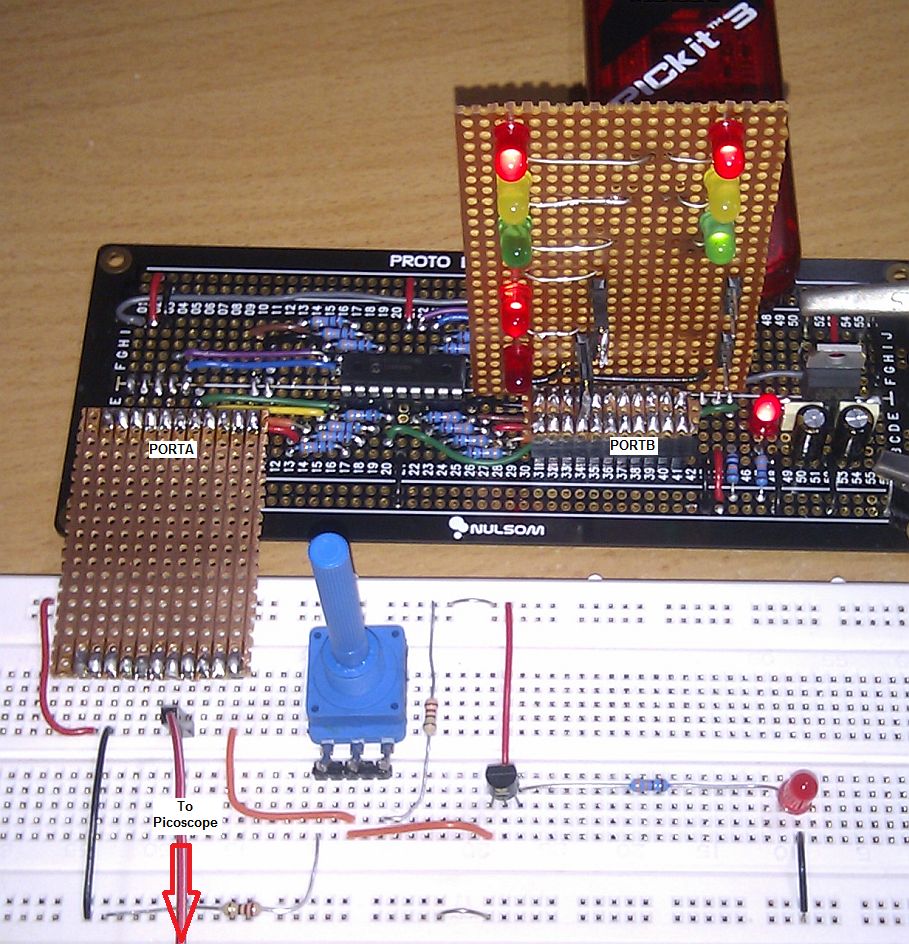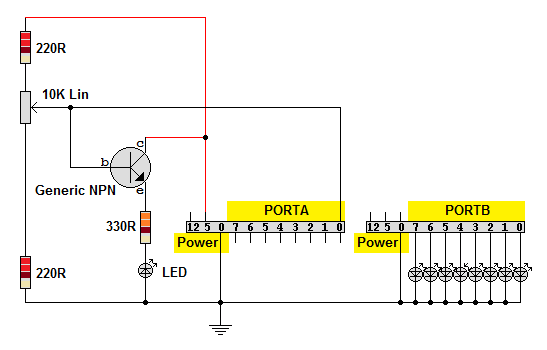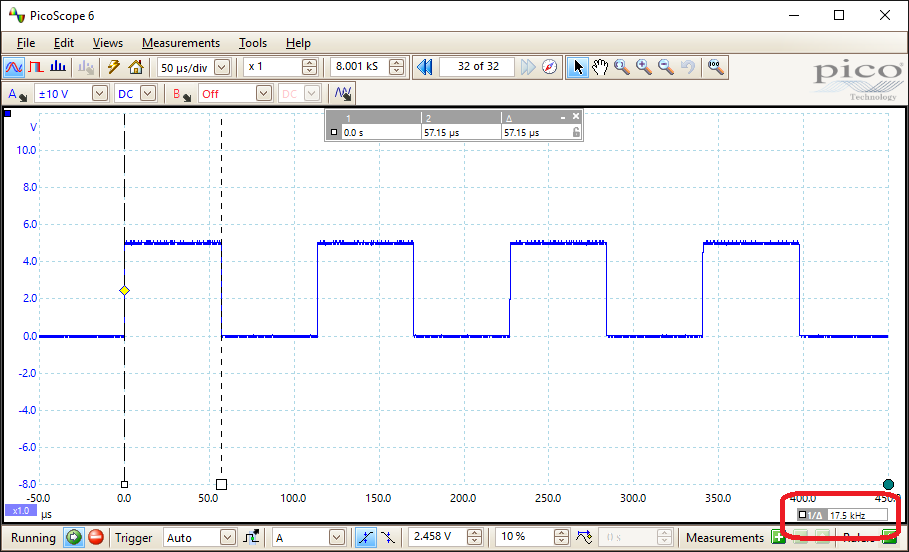

PIC16F88 0C ADC Input |
|

This circuit provides an analogue voltage to test the ADC function on the PIC16F88, plugged into PORTA, pin AN0/RA0.
The 220R resistors prevent potentiometer destruction if it's mis-wired.
It's OK to use a log pot if a linear one is not available.
The optional transistor and LED give a visual indication of the analogue voltage from close to 0 up to nearly 5Volts.
There are 8 LEDs, used to show the binary ADC output, plugged into PORTB.
Their 330R current limiting resistors are build onto the PIC16F88 board and not shown here.
The program repeatedly reads the ADC or potentiometer position and copies the value to the LEDs.
It's a 10 bit ADC. To show the result on the eight LEDs, the two least significant bits are discarded.
The accuracy drops from 1 part in 1024 to 1 part in 256. For a quick demonstration, this is not a problem.
For many applications this accuracy level would be more than enough. It's better than 1%. Most components are not that accurately manufactured.
With a 4 MHz clock, the chip managed over 17 000 conversions per second. This would be sufficient for good quality audio but not full frequency range HiFi.

;*******************************************************************************
; PIC16F88 Configuration Bit Settings
;*******************************************************************************
#include "p16F88.inc"
; CONFIG1: Internal RC Oscillator with I/O on RA6 and RA7. Turn of everything else.
__CONFIG _CONFIG1, _FOSC_INTOSCIO & _WDTE_OFF & _PWRTE_OFF & _MCLRE_OFF & _BOREN_OFF & _LVP_OFF & _CPD_OFF & _WRT_OFF & _CCPMX_RB0 & _CP_OFF
; CONFIG2: Allow Fail Safe Clocking. Turn off internal/external clock choice
__CONFIG _CONFIG2, _FCMEN_ON & _IESO_OFF
;*******************************************************************************
; Uninitialised Data - Reserve bytes here ...
;*******************************************************************************
UDATA
ADC_Result RES 1 ; reserves 1 byte for the ADC result
Del_Count RES 1 ; used in the delay loop
;*******************************************************************************
; RESET VECTOR
;*******************************************************************************
RES_VECT CODE 0x0000 ; processor reset vector
GOTO CODE_INIT ; beginning of program, initialise stuff
;*******************************************************************************
; INTERRUPT HANDLING
; This ought to save and restore the context
; It's not secessary in this simple example
;*******************************************************************************
ISR CODE 0x0004 ; The interrupt vector location is always 0x0004
BCF INTCON, GIE ; Prevent the interrupt from being interrupted
BANKSEL ADRESH
MOVF ADRESH, 0 ; Copy the 8 most significant ADC bits to WREG
BANKSEL PORTB
MOVWF PORTB ; Copy WERG to PORTB to show ADC result on LEDs
MOVLW b'11011110' ; to invert PORTA outputs but not RA5 or RA0
XORWF PORTA, 1 ; The PORTA bits are inverted so the conversion
; rate can be measured on an oscilloscope
CALL ADC_START ; Start the next conversion
RETFIE ; Return from interrupt
;*******************************************************************************
; MAIN PROGRAM - CODE INITIALISATION
;*******************************************************************************
MAIN_PROG CODE ; let linker place main program
CODE_INIT: ; INITIALISATION
CALL CLOCK_INIT ; Set the clock frequency
CALL PORT_INIT ; Set up I/O Port Directions
CALL ADC_INIT ; Set up A to D Converter
CALL ADC_START ; Start the ADC and wait for the completion interrupt.
GOTO IDLE_LOOP ; Jump to the Infinite Idle Loop - wait for interrupts
;*******************************************************************************
; INITIALISE CLOCK FREQUENCY - 4MHz - 1 microsecond per instruction
;*******************************************************************************
CLOCK_INIT:
BANKSEL OSCCON
movlw b'01100000' ; -110---- 4 MHz
movwf OSCCON ; At 4 MHz it's one microsecond per line of code.
RETURN
;*******************************************************************************
; INITIALISE PORTS
;*******************************************************************************
PORT_INIT:
BANKSEL TRISA
MOVLW b'00000001' ; Six Outputs. RA0/AN0 will be an analogue input. RA5 is always an input.
MOVWF TRISA ; Set PORTA data directions.
MOVLW b'00000000' ; Eight output lines for the eight LEDs
MOVWF TRISB ; Set PORTB data directions.
BANKSEL PORTA
MOVLW 0x00 ; Clear PORTA and PORTB
MOVWF PORTA
MOVWF PORTB
RETURN
;*******************************************************************************
; INITIALISE ADC
;*******************************************************************************
ADC_INIT:
BANKSEL ANSEL
MOVLW b'00000001' ; AN0 will be an analogue input. This is same pin as RA0.
MOVWF ANSEL ; Set Analogue Select Register
BANKSEL ADCON1
MOVLW b'00000000' ; Set up ADCON1
; ||||3210------- Not used
; ||54----------- Use power supply lines as voltage references
; |6------------- Don't divide AtoD clock source by 2 - ADCS2
; 7-------------- Left justify the result bits. Use ADRESH and discard the two bits in ADRESL
MOVWF ADCON1 ; Save settings to A to D Control Register 1
BANKSEL ADCON0
MOVLW b'01000001' ; Set up ADCON0 0xC1
; |||||||0------- 1 Turn on the ADC - ADON
; ||||||1-------- not used
; |||||2--------- 0 set this to one to start a conversion
; ||543---------- 000 selects channel 0, RA0/AN0
; 76------------- 01 divides 4MHz clock by 8 0.25us * 8 = 2 us OK because the safe range is 1.6 to 6.4 us
MOVWF ADCON0 ; Save settings to A to D Control Register 0
RETURN
;*******************************************************************************
; START ADC
;*******************************************************************************
ADC_START:
BANKSEL PIE1
BSF PIE1, ADIE ; Set A to D Interrupt Enable in the peripheral interrupt register
BANKSEL PIR1
BCF PIR1, ADIF ; Clear A to D Interruot flag in Peripheral interrupt register
BSF INTCON, PEIE ; Turn on Peripheral Interrupts
BSF INTCON, GIE ; Turn on Global Interrupts
MOVLW d'1' ; Delay d'1' * 4 + 2 + 2 =~ 8 microseconds
CALL DELAY_W ; Should be enough for the sample and hold to work
BANKSEL ADCON0
BSF ADCON0, GO ; Set the ADC GO bit - Start the AD Converter
RETURN
;*******************************************************************************
; The Idle Loop
; MS Windows has an "idle process" which waits for the user to do something.
;*******************************************************************************
IDLE_LOOP:
NOP
NOP ; NOPs make the code execution obvious in the simulator
NOP ; Leave them out in real life
NOP
GOTO IDLE_LOOP
;*******************************************************************************
; 200 microsecond delay at 4MHz clock
;*******************************************************************************
DELAY_W:
MOVWF Del_Count
D_LOOP:
NOP ; 1us
DECFSZ Del_Count, 1 ; Subtract 1, result goes into Del_Count
GOTO D_LOOP ; 2 us
RETURN
END
This trace measures A to D the conversions per second.
On each conversion, the PORTA bits were inverted so there were conversions on the rising and falling edges.
This gives about 17 500 samples per second. If your code needs to do other work, this rate would be slowed down.

Contact, Copyright, Cookies and Legalities: C Neil Bauers - reviseOmatic V4 - © 2016/17
Hosted at linode.com - London
Please report website problems to Neil